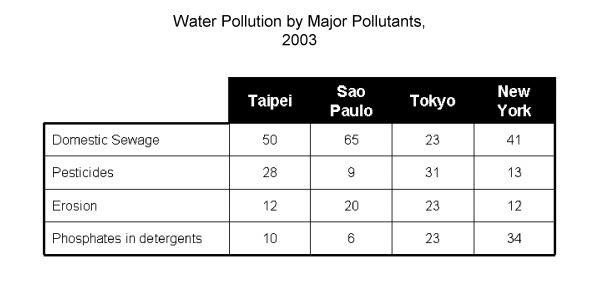The table below shows the average annual percentages of water pollution in four large cities in 2003.
Summarise the information by selecting and reporting the main features, and make comparisons where relevant.
The given table illustrates the regular yearly rate of polluted water by four main cities in 2003. Units are measured in percentage.
Overall, it is clear from the table that water in most of the cities was mainly polluted because of Domestic Sewage whereas Tokyo followed a completely different pattern.
At a fleeting glance, it can be vividly seen that in Taipei half of total water pollution was caused due to domestic sewage whereas pesticides caused roughly half of the water impurity than that of domestic drainage. Erosion and phosphates in detergents polluted almost the same amount of water with 12 and 10% respectively.
In São Paulo, the maximum amount of water was polluted because of the household sewage system. Secondary water pollution causing factor was erosion (20%) and pesticides were responsible for polluting 9% of water. Least water pollution in Sao Paulo was caused by detergents’ phosphates.
Probing further, in Tokyo 31% of water was contaminated by pesticides. Domestic sewage, erosion and phosphates in detergents polluted a similar proportion of water with 23% each. New York’s domesticated sewers and phosphates in washing powders polluted 41% and 34% of water orderly. Pesticides and erosion spoiled almost equal amounts of water with a difference of 1%.

